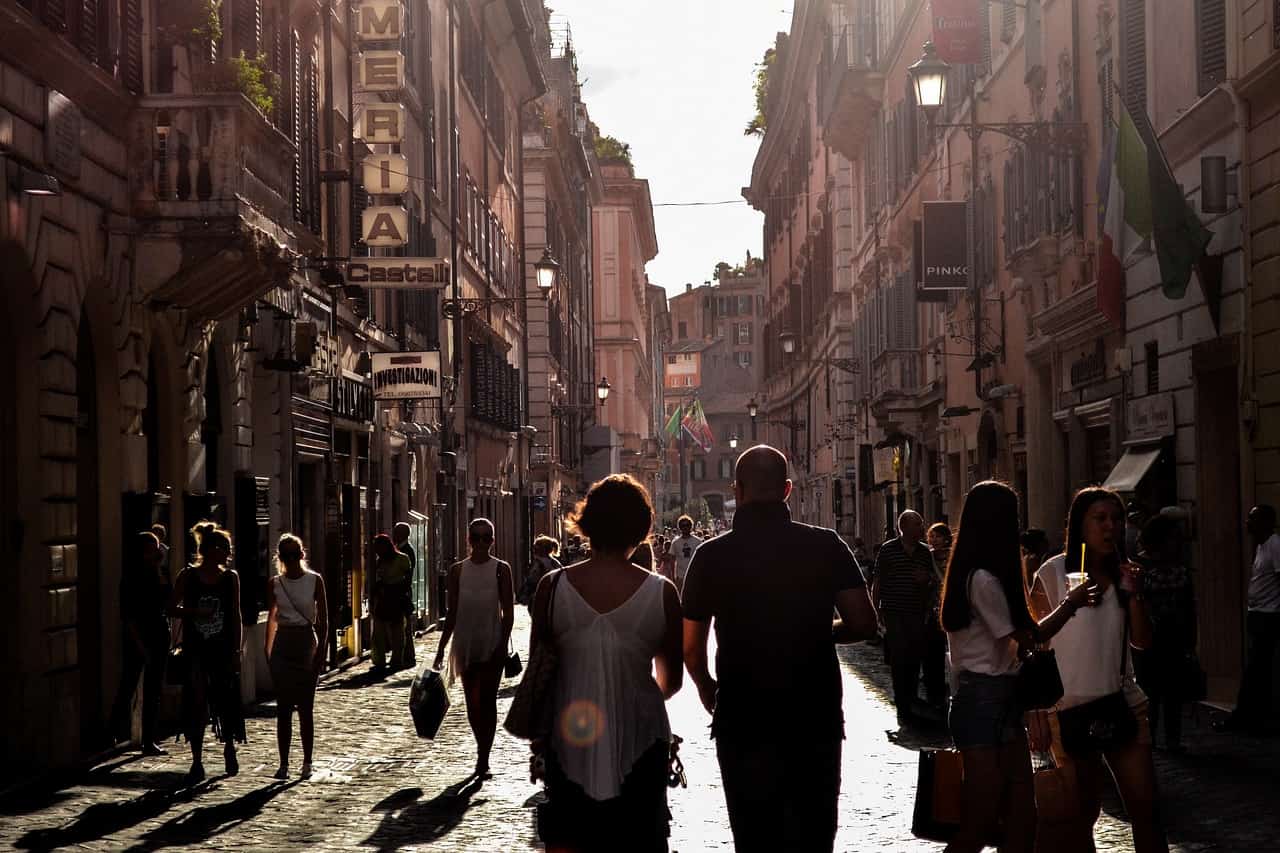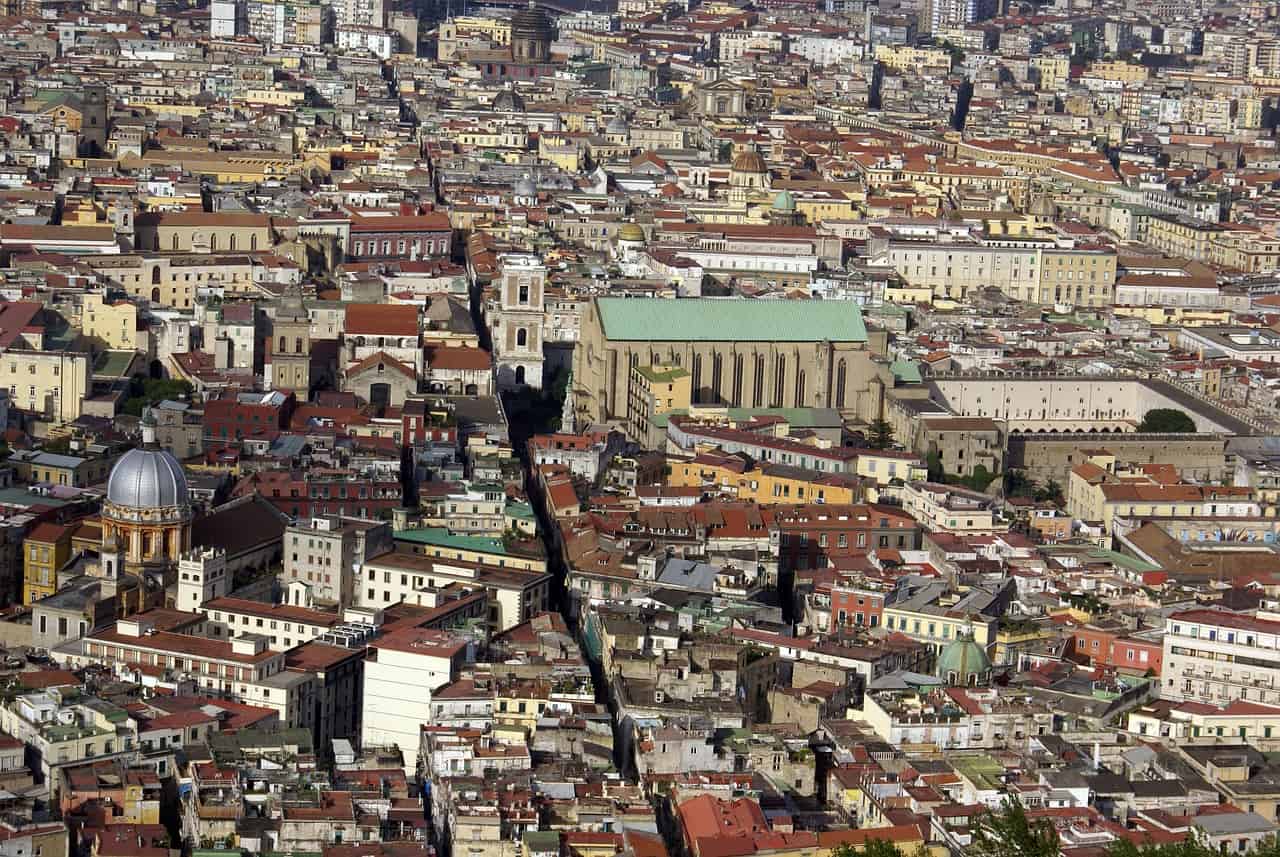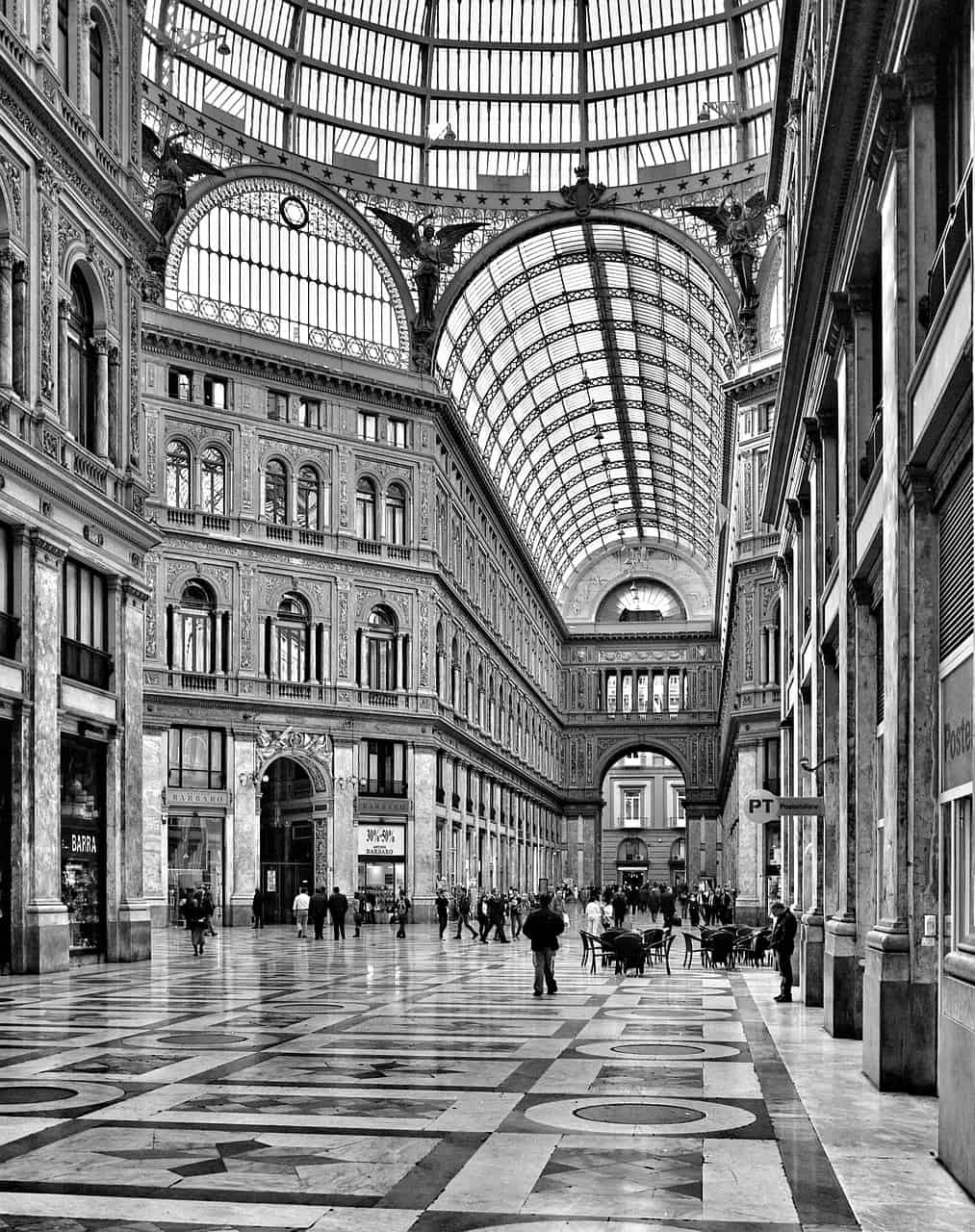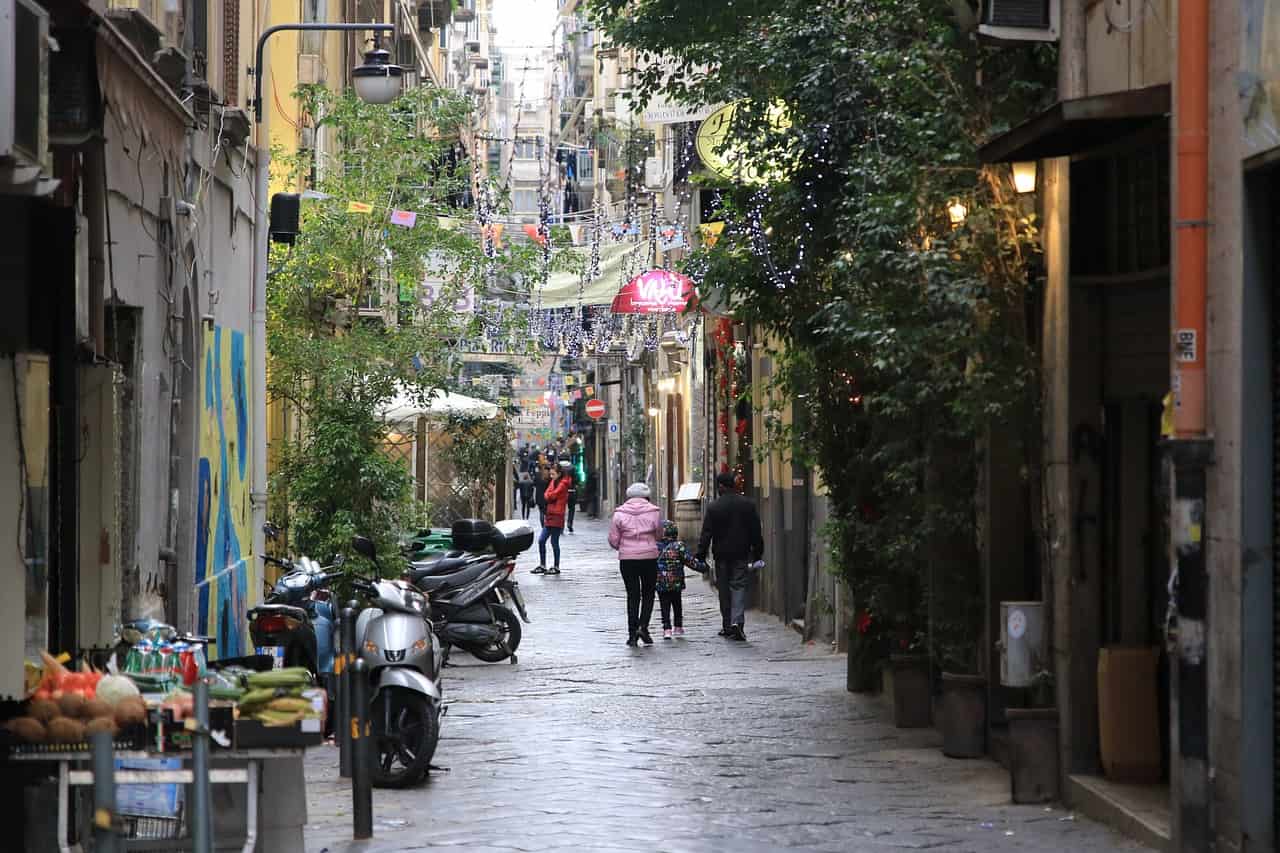A stop in Naples is on the list of many visitors to Italy, and it’s clear why many are drawn there.
This vibrant and at times gritty city is full of art museums, lively markets, delicious foods, the theater, and so much more.
One also finds a number of historical sites and landmarks, a variety of architectural styles from across the centuries, and a beautiful coastline.
The city has easy access to other locations as well such as Pompeii (25 miles/25.6 km), Sorrento (30.26 miles/48.7 km), and the Amalfi Coast (38 miles/60 km. Rome is also just a train ride away (140 miles/226.6 km).
Below are just a few of the places you might want to visit or experience while you are in this bustling city. These will give you a sense of all that the city has to offer.
For those who want to learn more about the area, we offer free walking tours of Naples.
Searching Availability...
1. The Food
One can’t help but think of “pizza” when one thinks of Napoli.
Their wood-fired Neapolitan pizza, with its simple, high-quality toppings and thin, soft crusts, is known worldwide.

The beloved Margherita pizza, made of tomatoes, basil, and mozzarella cheese, also comes from here.
But of course, there are other dishes you don’t want to miss.
Naples is known for its pasta as well, with dishes such as pasta e fagioli and sauces such as spaghetti alle vongole proving popular.
Naples has a fantastic street food scene, where you can find such delicious fare as arancini (fried rice balls) and pizza fritta.
Seafood lovers won’t want to miss the fresh seafood this coastal city offers.
And of course, desserts and coffee are a big part of any Neapolitan menu. Cannolis, zeppoles, stofliatella, espresso and cappuccino, all are sure to fill you up.
To experience the best of these in the city, consider taking a food tour or cooking class. These are surely the ways to find some of the best pizza, pasta, and other foods in the city.
2. Naples City Centre
The historic center of Naples, a city that dates back 2,800 years, is a World Heritage Site.
One can see why with its blend of historic, architectural, and artistic influences, along with its own district cultural traditions.

The various civilizations that settled here over time, peoples such as the Greeks, Romans, Byzantine, Norman, and Spanish, left their mark on the city.
Many architectural styles can be found there as well, such as Medieval, Gothic, Baroque, Renaissance, and Neoclassical.
Of course, over time it's also developed its own music, food, and religious traditions, all of which are a big part of citizens' lives.
Below (numbers 3-10) are just some of the sites that can be found within the city center.
3. Spaccanapoli
One can’t miss Spaccanapoli, the street that splits the city in half. In fact, the name means “Naples splitter”, something clear when seen from up above.
But Spaccanapoli is more than just a street that runs north to south for less than a mile.
It’s a zone or area of the city center, one that gives you a real sense of the character of Naples.

Its narrow, dark, cobblestone streets are full of shops, cafes, markets, bakeries, street food, monuments, street art, and dozens of churches.
Many folks suggest that some of the best pizzas in Naples can be found here.
It’s also rubbish strewn and often full of people. But it’s certainly lively and bustling, and often called “the real Naples”.
4. Naples National Archaeological Museum
The Museo Archeologico Nazionale de Napoli has some of the most significant archeological collections in the world.
There are artifacts from excavations of Herculaneum, Pompeii, and other locations in the region.
One of its most interesting draws is the Gbinetto Segreto (Secret Cabinet).
These contain artwork from both Herculaneum and Pompeii that are deemed explicit; ancient erotica, in other words.
It also has artworks and sculptures from the Farnese Collection, such as the Farnese Hercules, as well as Greek, Roman, and Egyptian creations.
There are items in silver, bronze, glass, and marble. One finds paintings, frescoes, gladiator attire, mosaics, and so much more.
It is truly one of the most attractive and fascinating museums in Italy and well worth a visit.
5. The Duomo di Napoli
The Duomo, considered one of the most beautiful buildings in the city, is known by a number of names: Naples Cathedral, Cattedrale di San Gennaro, and Cattedrale di Santa Maria Assunta.
This cathedral dates back to the 13th century having been commissioned by King Charles I of Anjou in 1294.
Over the course of its existence, a number of architectural styles were introduced, including Gothic, Renaissance, and Baroque.
The Duomo is magnificent in size and has ornately carved and painted ceilings. There are also relics, masterpiece artworks, and statues.
Ten side chapels can be found next to the church, some of which are particularly impressive in their own right. One is said to hold the blood of St. Januarius. His blood is believed to liquefy 3 times a year when it is then carried through the streets in a solemn procession.
The Duomo is free to enter. Tickets are needed for its special exhibits such as the Museum of the Treasures of San Gennaro.
6. Galleria Umberto I
Naples's oldest shopping gallery can be found near the waterfront and across from Teatre San Carlo.
Both locals and tourists fill the location, and it is a popular gathering place.
It’s worth stopping in for a short break so you can sit back and admire the real draw of the location - the ceiling.

The gallery’s glass and ironwork ceiling is reminiscent of Milan’s Galleria Vittorio Emanuele I.
There is a large central glass dome and side glass panels are laid out in the form of a cross.
Visitors will also find ornate architecture, sculptures, and floor mosaics.
While you’re there, you can pick up pastries at La Sfogliatella bakery.
The long lines are well earned as they are considered to have some of the world’s best Sfogliatella and Babà.
7. The Royal Palace of Naples
The royal palace (Palazzo Reale) was built in the 1600s to host King Phillip II of Spain, eventually becoming the royal residence of the Bourbons.
The unassuming "plainness" of the outside of the palace hides the fact that the interior is often referred to as stunning.
Inside, there are 31 rooms for guests to stroll through, including the Throne Room, Royal Apartments, and Hall of Hercules.
One finds tapestries, vaulted ceilings, magnificent paintings, ornate furniture, frescoes, statues, porcelain, and an incredible marble staircase.
The palace also has a commanding view of the Gulf of Naples and of Mount Vesuvius
Tickets to the Royal Palace can be found here.
Free audio guides are provided and needed, and it’s free to visit the small gardens and courtyard
The palace bookends Piazza del Plebiscito where many political events, concerts, and celebrations take place.
8. Teatro di San Carlo
One of the most famous theatres in Naples is Teatro di San Carlo.
It was opened in 1737 which makes it Europe’s oldest continuously open opera house.
Its magnificent interior, with its gilded stucco, six tiers of box seats, and frescoes, makes it the perfect backdrop for opera and ballet performances.
One can also attend the classical music performances of the San Carlo Theatre Orchestra.
Renovations were made in the late 1900s and the theatre is known for its good acoustics.
The theater sits next to the Royal Palace of Naples and can be visited by guided tour or through a show ticket.
Other theatres to visit include:
9. Beneath Naples
Underneath the city lies a network of underground caves, tunnels, and structures dating back to Greek and Roman times.
There are aqueducts to transport water and the remains of buildings from the city long past, all of it 40 meters beneath the surface of the present-day city.
A tour and tickets for Naples Underground can be found here.
There are also catacombs and cemeteries, the most well-known of which are the Catacombs of San Gennaro and Fontanelle Cemetery Cave.
In the catacombs of San Gennaro, which dates back to the 2nd century BCE one finds an enormous burial chamber and impressive frescos.
The bodies are no longer there. They were long ago moved, along with the bones from other sites across Naples, to Fontanelle Cemetary.
A tour and tickets for the Catacombs of San Gennaro can be found here.
During the Plague, many of the remains of tens of thousands of residents were added to Fonatanelle Cemetary, as were some of the dead from WWII.
Be prepared. You won’t find a cemetery in the modern sense. There are endless numbers of bones stacked in piles to the “ceiling”.
It’s considered one of the most haunted places in Europe by some. It is free to enter and locals visit to pay respects
10. The Spanish Quarter
The name for this part of the city, Quartieri Spagnoli, comes from the fact that Spanish troops were stationed there in the 16th and 17th centuries.
Its narrow streets, colorful facades, and noisiness reflect the vibrance of this crowded neighborhood.

There are loads of restaurants, cafes, bars, markets with vegetables and fish, hanging laundry, motorbikes, and so much more.
Don’t let the graffiti and grime fool you into thinking poorly of the area. The people are friendly and welcoming, and the hustle and bustle reflect Neopolitans living their daily lives.
The street art is well done and worth their own tour.
11. Castel Dell’Ovo
The “Egg Castle” or Castle of the Egg as it is known, sits on the Bay of Naples.
The name comes from a legend saying the Roman poet Virgil, who lived until 19 BCE and is best known for the Aerneid, had placed an egg in the castle.
The reasons for this depend on the story being told. Some think an egg, broken or unbroken, would reflect the state of the castle.
Of course, Virgil lived a thousand years before the castle was built. Its location was chosen for reasons of strategy due to its view over the bay.
The Catholic church eventually turned it into a monastery, which lasted until the Normans turned it back into a castle. It was also used as a bomb shelter during WWII.
There’s not much to do there but it’s worth seeing for the view, and is particularly lovely at sunset.
It's the perfect place to look out over Mount Vesuvius and along the coastline of Naples.
Castel dell'Ovo is free to visit, however, a paid tour will allow you to visit other parts of the castle.
As long as you’re down there, you may walk to stroll upon the seafront promenade (Lungomare Caracciolo).
The views are amazing, the walk is romantic, and you can admire villas and gardens along the way.
12. Vomero
If you'd like to get outside of the noise of the city center, you might enjoy a visit to Vemero, a suburb in the hills above Naples.
This upscale neighborhood can be easily reached by funicular, metro, or bus.
The Medieval Castel Sant'Elmo is found there. Its terrace provides 360-degree views of the area and it's highly recommended by many tourists despite the steep climb to the top.
The monastery Certosa e Museo di San Martino is also there and leaves visitors in awe with its stunning interior and works by Italian masters.
There are also lovely cafes and restaurants, markets, places to buy pizza and gelato, a football stadium, shopping, and some architecturally beautiful neighborhoods to walk through.
A number of tours go through there if you'd like a tour guide to take you through the area.
13. The Metro Stations
Normally metro stations wouldn't be on a list of recommendations for any given city.
However, aside from the practicality of using the metro to get around, you can find a world of art deep underneath the ground.
The Metro dell'Arte project has introduced contemporary art to the public by making the stations art museums of sorts.
There are 12 of them, some with mirrors and photographs, others with statues and artwork.
The one that should not be missed is the award-winning Toledo station, which has been named the most beautiful metro station in Europe.
This is an inexpensive activity as a single ticket costs just over a Euro and is under five Euros for a day ticket.
14. The Archeological Park of the Terme di Baia
Less than 30 minutes outside Naples is the seaside town of Baia.
This is where wealthy Romans built villas and temples, enjoyed private and public baths, and ate the freshest foods the sea had to offer.
Senators, generals, and emperors regularly visited this holiday resort.
In fact, the Emperor Nero spent time here. It was from this location that he ordered the murder of his mother, Agrippa the Younger, and her tomb can be found nearby.
Much of the city became submerged due to volcanic activities that caused parts of it to slide into the sea.
But there is still plenty to see on land, including ancient Roman structures, baths, frescoes, mosaics, and a museum.
Nearby is the Underwater Archeological Marine Park of Baia. Visitors can go scuba diving or snorkeling and find ruins (and copies) of statues and mosaics under the water.
Also worth visiting are the nearby attractions of Archeological Park at Cumai, Castello Aragonese, and the Flavian Amphitheatre at Pozzuioli.
15. Pompeii and Mt Vesuvius
Not far from Naples is Pompeii, one of the most visited tourist attractions in Italy.
The historical significance of Pompeii, and what provokes much emotion, lies in its vivid snapshot of life in an ancient Roman city, frozen in time due to the devastating eruption of Mount Vesuvius in 79 AD.
Under the ash, one finds the remnants of a bustling and thriving city, with people going about their daily duties having no idea what was soon to befall them.
Most touching are the bodies that lie in the ruins of Pompeii, people frozen in their last terror-filled moments for eternity.
Visitors have been climbing the crater since the 1600s, and today can climb an “easy” part of it to get take in the view.
Note that Mount Vesuvius is still active and is one of the most intensely observed volcanic sites in the world.
Our post on how to visit the Pompeii ruins will be quite helpful to visitors, as will our Pompeii tickets and discounts post.



